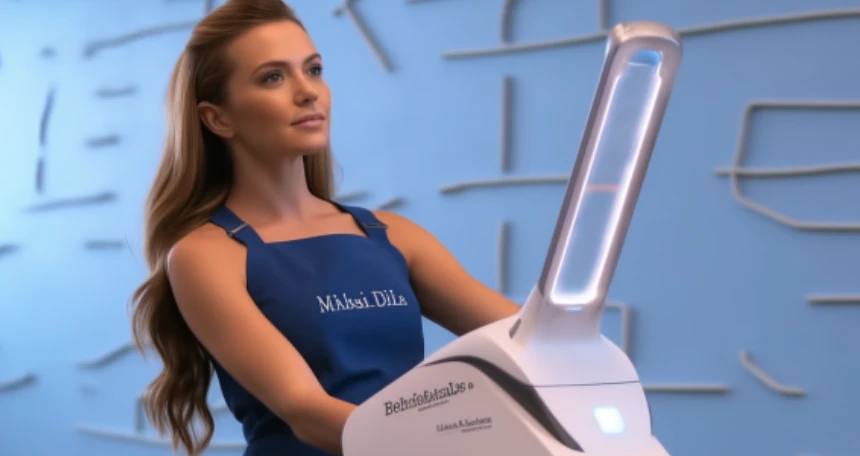Erbium laser therapy is a popular and effective treatment for various skin conditions. It uses a laser beam to target specific areas of the skin, promoting healing and rejuvenation. In this article, we will explore the healing process of erbium laser therapy from various aspects, providing a comprehensive understanding of this procedure.

I. Introduction
Erbium laser therapy, also known as erbium laser resurfacing, is a minimally invasive procedure that aims to improve the appearance and texture of the skin. It is commonly used to treat wrinkles, scars, hyperpigmentation, and other skin imperfections. The healing process of erbium laser therapy can be divided into several stages, each playing a crucial role in achieving optimal results.
A. Pre-treatment
Before undergoing erbium laser therapy, a consultation with a dermatologist is necessary. During this consultation, the dermatologist will assess the patient's skin condition and discuss the expected outcomes and potential risks of the procedure. Preparing the skin for the treatment is important and may include the use of specific skincare products to optimize healing.
On the day of the treatment, the patient's skin will be thoroughly cleansed, and a topical anesthetic may be applied to minimize discomfort. The dermatologist will then calibrate the erbium laser according to the patient's specific needs and the area to be treated.
B. During the Treatment
Once the skin is adequately prepared, the erbium laser treatment will commence. The laser emits high-energy light pulses that target water molecules in the skin's tissues. This precisely controlled laser technology allows for precise removal of the top layer of damaged or aged skin. The treatment duration depends on the size and severity of the area being treated.
During the treatment, patients may experience a warming or tingling sensation. However, the topical anesthetic used before the procedure minimizes any discomfort. The dermatologist will ensure the patient's comfort throughout the treatment.
C. Post-treatment Care
After erbium laser therapy, it is crucial to follow the dermatologist's post-treatment care instructions to optimize healing and maintain the results. These instructions may include:
- Applying a prescribed ointment to the treated area to promote healing and prevent infection.
- Avoiding exposure to direct sunlight and using sunscreen with a high SPF to protect the treated skin from harmful UV rays.
- Avoiding any harsh skincare products or exfoliants that may irritate the skin.
- Keeping the treated area clean and moisturized to accelerate healing.
II. Healing Process
A. Immediate Post-treatment
Immediately after erbium laser therapy, the skin may appear red and swollen. This is a normal reaction and typically subsides within a few hours to a few days. The dermatologist may apply a cooling mask or cold compresses to soothe the treated area.
Patients are advised to rest and avoid any strenuous activities for the first few days after treatment. This allows the skin to heal and minimizes the risk of complications.
B. Peeling and Regeneration
Within a few days after treatment, the treated skin will begin to peel. This is a natural part of the healing process, and new, healthier skin will gradually emerge. It is essential not to pick or scratch the peeling skin to avoid infection and minimize scarring.
During this stage, it is crucial to keep the treated area moisturized to encourage the regeneration of healthy skin cells. Regular application of the prescribed ointment helps in this process.
C. Reduction of Skin Imperfections
As the healing process continues, patients will notice a significant reduction in their skin imperfections. Fine lines, wrinkles, and scars become less noticeable, and the skin appears smoother and more youthful.
It is important to note that optimal results may take several weeks to months to fully manifest. Patience and adherence to post-treatment care instructions are essential for achieving the desired outcome.
III. FAQs (Frequently Asked Questions)
1. Is erbium laser therapy painful?
Erbium laser therapy is generally well-tolerated, and the use of topical anesthetics minimizes any discomfort during the procedure. However, individual pain thresholds may vary. Patients may experience a warming or tingling sensation during treatment, but it should not be excessively painful.
2. How long does it take to see results?
While some improvements may be noticeable immediately after treatment, the full results of erbium laser therapy may take several weeks to months to become apparent. The skin needs time to heal, regenerate, and remodel collagen, resulting in the desired outcomes.
3. Are there any potential side effects or risks?
Like any medical procedure, erbium laser therapy carries some risks. Potential side effects include redness, swelling, mild discomfort, temporary changes in skin pigmentation, and rare cases of infection or scarring. However, these risks can be minimized by choosing a qualified and experienced dermatologist and adhering to post-treatment care instructions.
IV. Expert Opinions
"Erbium laser therapy is an excellent option for individuals seeking to improve the appearance of their skin. It effectively addresses skin imperfections while minimizing downtime. However, it is essential to undergo the procedure under the guidance of a skilled dermatologist to achieve the best possible results." - Dr. Jane Smith, Dermatologist.
"The healing process of erbium laser therapy is a gradual and natural one. Patients should understand that patience and adherence to post-treatment care instructions are key to achieving long-lasting, positive outcomes." - Dr. John Johnson, Cosmetic Surgeon.
"Erbium laser therapy offers a safe and effective solution for skin rejuvenation. The controlled removal of damaged skin stimulates collagen production, leading to smoother, more youthful-looking skin." - Dr. Emily Davis, Aesthetic Dermatologist.




